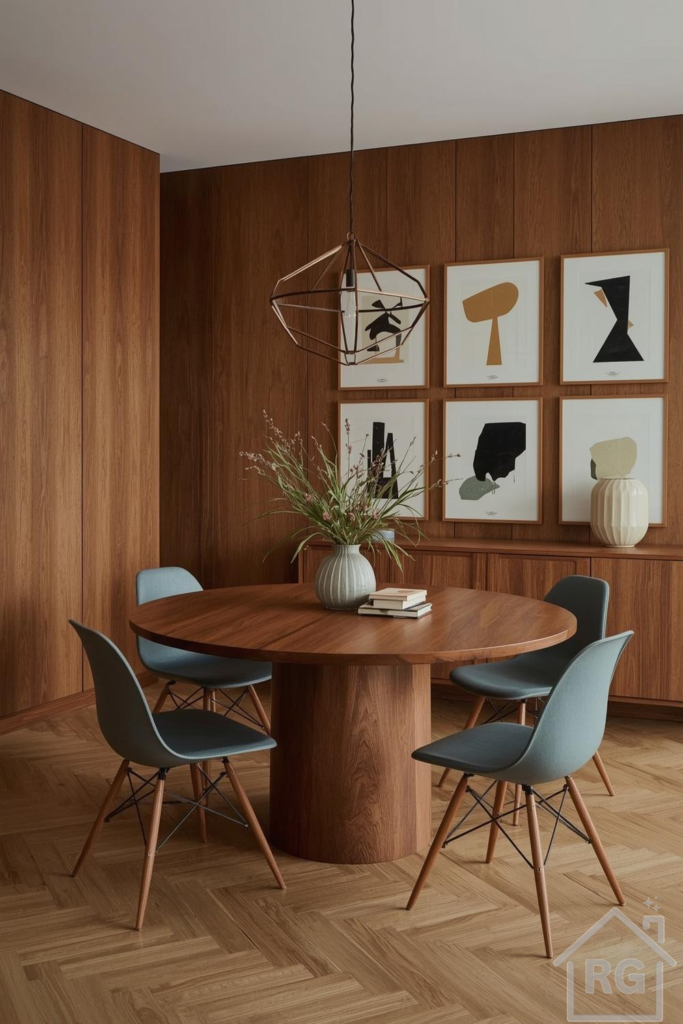
Step into a realm where timeless design meets inviting warmth — the mid-century modern dining room. This iconic style, born from the post-war era’s desire for functional yet beautiful spaces, continues to captivate with its clean lines, organic forms, and emphasis on natural materials. The image before us perfectly encapsulates this aesthetic, offering a masterclass in creating a sophisticated and welcoming dining environment that feels both classic and utterly contemporary.
Embracing the Warmth of Wood
The most striking feature of this dining room is undoubtedly its pervasive use of wood, which bathes the space in a rich, earthy glow. The walls are clad in stunning, vertically paneled wood, likely a warm walnut or teak, creating an enveloping sense of intimacy and luxury. This isn’t just a decorative choice; it’s a foundational element that defines the room’s character. The deep, reddish-brown hues of the paneling provide a comforting backdrop, making the space feel grounded and serene. This continuous application of wood, from the floor to the walls and even the integrated cabinetry, creates a seamless, cohesive envelope that speaks to thoughtful craftsmanship.
The round dining table, a central focal point, continues this narrative of natural elegance. Its substantial pedestal base and smooth, circular top are crafted from the same rich wood, ensuring visual harmony with the surrounding elements. The grain of the wood is visible, adding subtle texture and a connection to nature. This choice of a round table is inherently inviting, fostering conversation and connection among diners, a hallmark of mid-century design’s focus on human interaction.
Complementing the wall paneling and table is the exquisite herringbone wood flooring. The intricate pattern adds a layer of sophisticated texture underfoot, reflecting light and adding visual interest without overwhelming the space. The lighter, golden-brown tones of the floor provide a gentle contrast to the deeper wall paneling, preventing the room from feeling too dark and ensuring a sense of spaciousness. This interplay of different wood tones and textures demonstrates a masterful understanding of material use, creating depth and visual richness.
A Harmonious Color Palette
While wood dominates, the room’s color palette is carefully balanced to introduce softness and visual intrigue. The primary colors are the warm browns and tans of the wood, ranging from deep walnut to lighter oak. Against this backdrop, the dining chairs introduce a calming counterpoint. Upholstered in a muted blue-grey fabric, these chairs offer a cool, sophisticated contrast to the warmth of the wood. This particular shade of blue-grey is neither too vibrant nor too stark; it’s a serene, almost dusty tone that evokes tranquility and complements the natural materials beautifully. The combination of warm wood and cool blue is a classic design pairing, creating a sense of balance and refined elegance.
The art on the walls further enriches the palette with subtle pops of color. The abstract prints feature a minimalist aesthetic, incorporating shades of black, white, and a warm ochre or mustard yellow. These artistic touches echo the room’s overall earthy and sophisticated feel, adding visual interest without detracting from the serene atmosphere. The white matting and simple frames of the artwork provide a clean break against the wood paneling, allowing each piece to stand out.
Even the decorative elements contribute to the color story. The ribbed ceramic vase on the table, in a soft, off-white or light grey, provides a neutral anchor, allowing the natural greenery it holds to introduce a touch of organic freshness. Another sculptural vase on the sideboard, with its creamy, textured surface, adds another layer of subtle color and form.
Iconic Mid-Century Furniture Choices
The furniture in this dining room is a testament to the enduring appeal of mid-century modern design, prioritizing both aesthetics and ergonomics. The round pedestal dining table is a quintessential mid-century piece, known for its clean lines and ability to maximize legroom. Its solid, sculptural base provides stability and a strong visual anchor in the center of the room, while its circular shape encourages intimate gatherings and easy conversation.
The dining chairs, reminiscent of classic Eames designs, are perfectly suited to the table and the overall aesthetic. Their molded seats, upholstered in the aforementioned blue-grey fabric, offer comfort and support, while the slender wooden legs with their black wire cross-bracing provide a light, airy contrast to the table’s solidity. These chairs embody the mid-century ethos of combining innovative materials and manufacturing techniques with organic, human-centric forms. Their elegant simplicity ensures they don’t overpower the space but rather enhance its sophisticated charm.
Illuminating Style: The Statement Pendant
Lighting in a mid-century space is often more than just functional; it’s a sculptural element. The geometric pendant light hanging above the table is a prime example. Crafted from a bronze or copper-toned metal, its open, angular form creates a striking visual statement without feeling heavy or obstructive. The exposed bulb within adds to its industrial-chic appeal, while the warm metallic finish complements the rich wood tones of the room. This fixture not only provides essential illumination but also acts as a piece of art, drawing the eye upwards and adding a contemporary edge to the classic mid-century setting.
Curated Art and Thoughtful Decor
The gallery wall is a masterstroke in this dining room, showcasing six abstract prints that perfectly align with the minimalist and organic sensibilities of mid-century modern art. The prints feature simple shapes and a limited color palette of black, white, ochre, and muted grey, creating a cohesive visual narrative. Arranged in a grid, they add structure and a focal point to the expansive wood-paneled wall, breaking up the large surface area and adding personality. The art is sophisticated yet approachable, inviting contemplation without being overly complex.
On the dining table, a ribbed ceramic vase holds a delicate arrangement of dried grasses and slender floral stems. This natural element introduces softness and an organic touch, contrasting beautifully with the clean lines of the furniture and the geometric light fixture. The vase’s texture adds subtle visual interest, while its neutral color ensures it blends seamlessly with the overall palette. A stack of books beside it adds a touch of lived-in comfort and intellectual charm, suggesting a space that is not only beautiful but also functional for everyday life.
On the integrated sideboard beneath the art, another unique decorative piece, a creamy, textured vase or sculptural object, further enhances the room’s curated feel. These carefully chosen accessories demonstrate that even small details can significantly contribute to the overall aesthetic, adding layers of texture and visual appeal.
Designing for Flow and Functionality
Beyond its aesthetic appeal, this dining room is designed with functionality in mind. The built-in wood paneling cleverly conceals storage, likely cabinetry or even a hidden pantry, maintaining the room’s sleek, uncluttered appearance. This seamless integration of storage is a hallmark of well-designed spaces, ensuring that practical needs are met without compromising on style. The open layout, with ample space around the round table, allows for easy movement and comfortable seating, making it an ideal space for entertaining or daily family meals.
The choice of a round table also contributes to the room’s flow, as it lacks sharp corners, making it easier to navigate around in a compact or open-plan space. The thoughtful placement of the pendant light directly above the table ensures optimal illumination for dining, while the overall lighting scheme likely includes recessed lighting or other ambient sources to create a warm and inviting glow throughout the room.
Bringing Mid-Century Modern Home: Your Design Checklist
- Start with a Strong Foundation: Embrace natural wood. Whether it’s wall paneling, flooring, or key furniture pieces, rich wood tones like walnut, teak, or oak are essential. Consider the interplay of different wood shades for depth.
- Choose Your Signature Pieces: Invest in iconic mid-century furniture. A pedestal dining table, Eames-style chairs, or a sleek sideboard can instantly define your space. Look for pieces that combine clean lines with organic forms.
- Layer Your Lighting: Select a statement pendant light that doubles as a sculptural art piece. Geometric shapes, warm metals (like bronze or copper), and exposed bulbs are excellent choices. Supplement with ambient lighting for a warm glow.
- Curate Your Art: Opt for abstract or minimalist art. A gallery wall with framed prints in a cohesive color palette (think black, white, ochre, and muted tones) can add sophistication and personality without overwhelming the space.
- Add Organic Touches: Introduce natural elements like plants, dried floral arrangements, or ceramic vases. These soften the clean lines of mid-century furniture and bring a sense of life and freshness to the room.
- Consider Built-in Storage: If possible, integrate storage solutions that blend seamlessly with your walls or furniture. This helps maintain a clutter-free, minimalist aesthetic, which is crucial for mid-century design.
- Embrace a Balanced Palette: Combine warm wood tones with cool, muted colors like blue-grey, sage green, or charcoal. Use neutrals like off-white and cream to provide breathing room and allow key elements to shine.
This mid-century modern dining room is more than just a collection of furniture; it’s a masterfully designed space that exudes warmth, sophistication, and timeless appeal. By thoughtfully combining natural materials, iconic designs, and a harmonious color palette, it creates an inviting atmosphere perfect for gathering, dining, and making lasting memories. Let this exquisite example inspire your journey to creating your own mid-century sanctuary.
